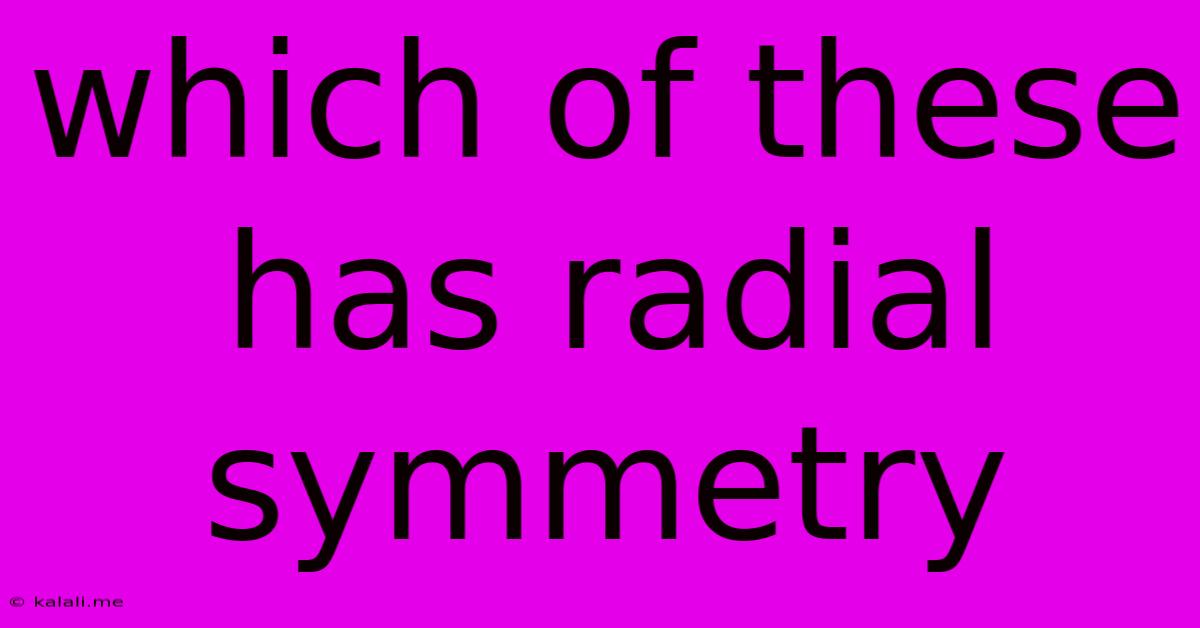Which Of These Has Radial Symmetry
Kalali
Jun 15, 2025 · 3 min read

Table of Contents
Which of These Has Radial Symmetry? Understanding Symmetry in Nature
This article will explore radial symmetry, contrasting it with bilateral symmetry and providing clear examples of organisms exhibiting radial symmetry. Understanding symmetry in biology is crucial for classifying and understanding the evolutionary relationships between different species. This guide will help you easily identify radially symmetrical organisms.
Radial symmetry, also known as rotational symmetry, is a type of symmetry where an organism can be divided into similar halves by multiple planes passing through a central axis. Imagine cutting a pie – you can make multiple cuts from the center, creating equal slices. This contrasts sharply with bilateral symmetry, where an organism can only be divided into two mirror-image halves by a single plane (like cutting a human body down the middle).
Key Differences Between Radial and Bilateral Symmetry:
- Radial Symmetry: Multiple planes of symmetry; often found in sessile (stationary) or slow-moving organisms. Think of a starfish or a jellyfish.
- Bilateral Symmetry: Single plane of symmetry; commonly found in actively moving organisms. Think of a human, a dog, or a butterfly.
Examples of Organisms with Radial Symmetry:
-
Cnidarians (Jellyfish, Anemones, Corals): These aquatic invertebrates exhibit classic radial symmetry. Their bodies are organized around a central mouth, with tentacles radiating outwards. This arrangement allows them to effectively capture prey from any direction. The intricate beauty and diverse forms of cnidarians showcase the elegance of radial symmetry in the ocean's ecosystems.
-
Echinoderms (Starfish, Sea Urchins, Sea Cucumbers): These marine animals are famous for their radial symmetry. Starfish, in particular, are iconic examples, with their arms radiating from a central disc. The five-point radial symmetry is a defining characteristic of many starfish species, contributing to their unique ability to regenerate lost limbs. Sea urchins also display a striking radial symmetry in their spiny bodies.
-
Some Plants: Certain flowers and other plant structures exhibit radial symmetry. For instance, many flowers can be divided into multiple equal sections from their central axis, demonstrating a clear example of radial symmetry in the plant kingdom. This symmetry is often vital for pollination, attracting pollinators from all directions.
Organisms that Don't Have Radial Symmetry:
To better understand radial symmetry, it's helpful to consider organisms that lack it. Most animals with complex body plans, such as mammals, birds, reptiles, amphibians, and insects, exhibit bilateral symmetry. Their body parts are arranged in a symmetrical manner around a central axis, but this axis allows only one plane of symmetry.
Advantages of Radial Symmetry:
The evolutionary advantage of radial symmetry lies in its effectiveness for sessile or slow-moving organisms. It allows them to interact with their environment equally from all directions. This is particularly important for predation and defense. For example, a sea anemone with radial symmetry can capture prey approaching from any angle.
In Conclusion:
Understanding the differences between radial and bilateral symmetry is fundamental to appreciating the diversity of life on Earth. While bilateral symmetry is prevalent in many actively moving organisms, radial symmetry is a striking adaptation in sessile or slow-moving creatures, providing efficient interaction with their surrounding environment. The next time you encounter a starfish or a jellyfish, remember the remarkable elegance and functionality of radial symmetry.
Latest Posts
Latest Posts
-
I Overtook 2nd Place What Is My Position
Jun 16, 2025
-
Modulus Of Elasticity Of Mild Steel
Jun 16, 2025
-
What Is The Transmission Of Light
Jun 16, 2025
-
Jelly Like Substance In A Cell
Jun 16, 2025
-
Which Of The Following Is True Regarding A Clamp On Ammeter
Jun 16, 2025
Related Post
Thank you for visiting our website which covers about Which Of These Has Radial Symmetry . We hope the information provided has been useful to you. Feel free to contact us if you have any questions or need further assistance. See you next time and don't miss to bookmark.